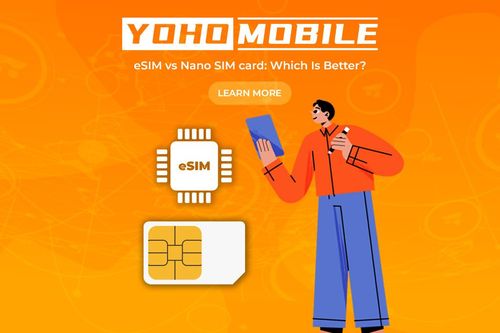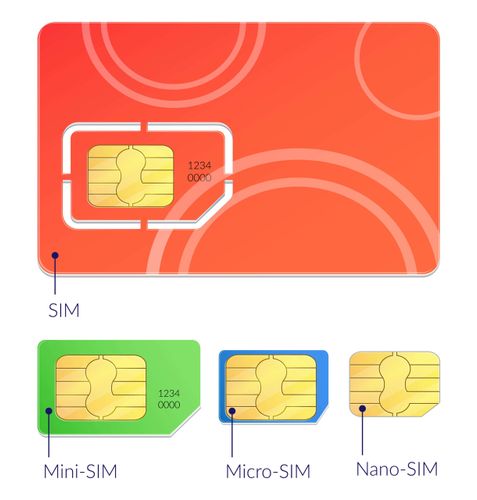The tech-savvy eSIM vs the good-old Nano SIM? Certainly, the two options have their pros and cons. eSIMs, the latest tech, are integrated directly into your phone, allowing for thinner designs, improved security, and more features. Nano SIMs, on the other side of the spectrum, are the current standard and can be more convenient in some situations.
So, when it comes to eSIM vs Nano SIM, which one suits your traveling lifestyle best? Let’s weigh the options to help you find your perfect fit!

Image by Vecteezy
You Might Also Like: eSIM vs Physical SIM: What You Shouldn’t Miss
In this article:
- What is a Nano SIM card?
- Is Nano SIM the right choice for you?
- What are the downsides of Nano SIM cards?
- Is eSIM better than Nano SIM?
- What are the disadvantages of eSIM vs Nano SIM?
- How to get started with eSIMs today
What is a Nano SIM card?
Nano SIMs are the latest gen of SIM cards. These chips are made to be small, which is critical in the tech and mobile world right now. That specific feature also allows manufacturers to make thinner, more compact phones that are convenient for traveling, albeit slightly lagging behind eSIMs in this regard. But the real upper hand of Nano SIMs is beyond aesthetics. The clearer advantage of a Nano SIM is its widespread usage within a vast array of devices.

Image by macrovector on Freepik
Related: eSIM vs iSIM: An Easy Guide
Is Nano SIM the Right Choice For You?
Nano SIMs are still among the most popular options due to their solid advantages, even as newer eSIM tech is gaining ground. Let’s explore these benefits to see if a Nano SIM aligns with your travel needs.
- Freedom to Choose: While some eSIMs can be locked to a carrier sometimes, Nano SIMs offer more flexibility in that sense. You can easily switch between carriers by simply swapping the SIM card.
- Offline Advantage: A key strength of Nano SIMs is their physical form, as you can easily remove and transfer them between devices. This is particularly useful in situations where you need to get connected fast without waiting for remote setup or QR activation.
- Simple and Transferable: Nano SIMs are as user-friendly as traditional SIM cards. They are simply physical cards you can easily put in or take out of a phone without any fuss. You can get them to work with minimal technical knowledge, unlike eSIMs, which require compatible devices and some basic know-how to get them going. They’re ideal for those who prefer a straightforward approach.
- Switching Phones: Since your network profile is stored on a physical chip within the Nano SIM, it is easier to switch phones. Actually, swapping the SIM card takes just seconds.
- Wider Compatibility: Nano SIM cards work with most phones and networks, and offer the broadest compatibility when compared to eSIMs. Want to ensure your SIM will work with a wide range of devices and carriers? a Nano SIM is a reliable choice.
What Are the Downsides of Nano SIM cards?
- Security Risks and Potential for Fraud: While generally durable, physical SIMs can be damaged or lost, and getting them replaced might not always be a smooth process. In the worst-case scenario, they could be stolen, posing a serious security threat. For instance, it could let someone access your phone number, data, and billing info without permission. If a Nano SIM gets hacked, bad actors can use your phone to make calls and texts, and even get into your personal information. That’s because some carriers keep things like contacts and messages on the SIM, which can be easy targets.
- Environmental Impact: The process of making traditional SIM cards involves plastics and metals, contributing to resource depletion. Likewise, packaging and shipping of physical SIM cards add to greenhouse gas emissions.
- Roaming Costs: Using your phone abroad with a Nano SIM can incur expensive roaming charges.
- Network Switching Hassle: Switching carriers involves physically obtaining a new SIM card, unlike the ease of eSIMs.
Is eSIM better than Nano SIM?
Are eSIMs a life-made-easier tech or just an overhyped trend? Time to talk about the famous eSIM tech to figure out if it lives up to the hype! But first, what exactly is an eSIM and how do they work? Discover the intricacies of it in our easy-to-understand guide.
- Easy Switching: eSIMs reside within your device, hidden from view yet always present. Almost like secret agents in your phone to let you switch carriers or plans with just a few taps, so you do not need new cards, store visits, or fiddling with tiny trays. Impressive, ah?
- Higher Security: Unlike SIM cards, eSIMs are tamper-proof. This crucial aspect makes them safer against theft and unauthorized use, and it helps authorities track lost phones more easily.
- Globetrotter’s Dream: eSIMs can be a great companion for nomads, remote workers, or avid travelers. Since many eSIM providers offer global plans, users can easily switch between carriers across the globe without delay or searching for a specific data plan. This is great for finding the best deals across different countries or regions.
- Multiple Profiles: Some eSIM-compatible devices allow storing multiple profiles. This is ideal for areas with spotty coverage, letting you switch to a carrier with better reception on the fly.
- IoT-ready: eSIMs are tiny and perfect for the Internet of Things (IoT) boom, more than Nano Sim can ever be. They can be embedded in wearables, trackers, and even smart home devices, enabling seamless connectivity without bulky components.
- A Smart Choice for the Future: Beyond all of these above, eSIMs offer other benefits in the long run. Their small size frees up space for bigger batteries or innovative features.
- Eco-Friendly Champion: eSIMs do not require any plastic or metals like traditional SIM cards do, making them the greenest option available. Even the smallest contribution, like an eSIM, can make a great difference!
In short, eSIMs offer a shortcut into a future of streamlined connectivity, security, and convenience. Yet it’s essential to weigh the pros and cons objectively.
What are the disadvantages of eSIM vs Nano SIM?
While eSIMs offer convenience and new innovative features, there are some challenges to consider compared to traditional Nano SIMs.
- Network Limitations: Not all carriers, especially smaller ones, offer eSIM support. Availability can vary by country and phone model. Even when your phone is eSIM-ready, it might not work with all networks
- Activation Challenges: eSIMs require an internet connection for activation and setup. This could cause problems in an area without Wi-Fi or cellular data.
- Switching Hassle: Switching phones with an eSIM isn’t as simple as swapping a physical SIM. While still possible, it often involves installing apps, entering carrier codes, and deactivating the eSIM on your old device.
- Fixing issues: It’s harder to troubleshoot connection issues with eSIMs because you can’t just try your SIM in another phone like you can with Nano SIMs.
Interest in eSIM? Here’s How to Get Started Today
Starting with eSIM couldn’t be easier thanks to Yoho Mobile. Launched in 2022, they offer affordable data plans that work in many countries thanks to their 30+ carrier partnerships. But they’re not just about data - they care about the environment and helping people in need. They even give away free data in disaster areas! Here’s how to get started with Yoho Mobile today!

Image by Vecteezy
-
First of all, Check Your Phone:
- Make sure your phone (like iPhone or Samsung) can use eSIMs (check Yoho Mobile’s list).
- If your phone is locked (mostly happens in North America), unlock it from your carrier.
-
Choose Your Plan:
- Pick a plan for your destination (single country or region).
- Consider data amount and trip length (e.g., 1GB for a week vs. unlimited for a month).
-
Set Up Your eSIM:
- Buy online before you travel.
- Scan a QR code or enter details (activate 1 day before with Wi-Fi).
- Follow Yoho Mobile’s guide for iPhone, Samsung, or Google Pixel.
-
Activate Your eSIM:
- Once you’re in the destination country, activate the eSIM.
- Check your phone settings to confirm Yoho Mobile eSIM is active.
-
Simply, Enjoy Your Trip!
- Stay connected with Yoho Mobile eSIM with absolutely no roaming fees!
- You can still use your regular phone number for calls/texts (check with your carrier for fees).
- Check data usage in your Yoho Mobile account.
- Share your data connection with others using Mobile Hotspot.
